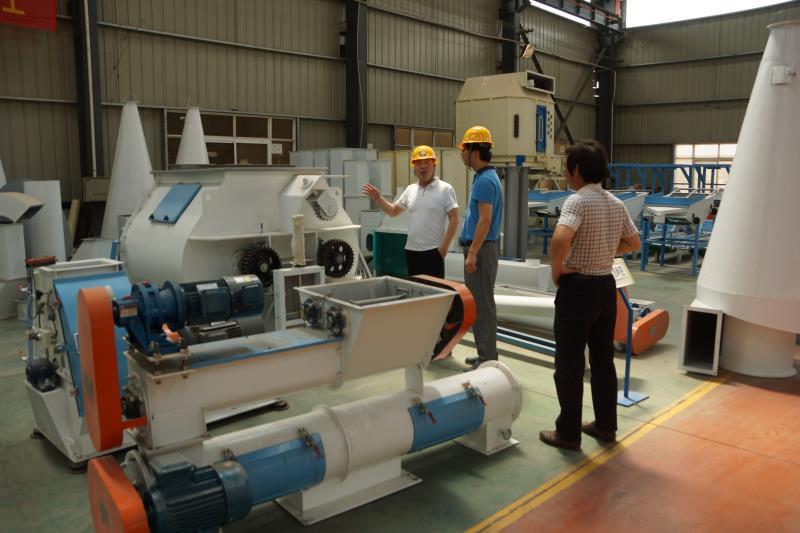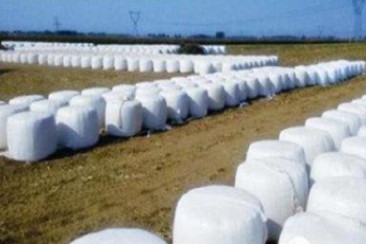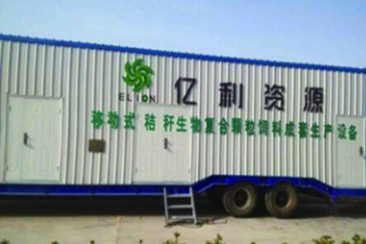Double rotor shredder
- Production capacity: 3-10t/h
- Applicable materials: Straw crushing, etc.
- Applications: Pastures, feed mills, etc.
Classification:

Tel:
Introduction
-
Hammer mill is generally used for crushing straw materials, and its structure consists of three parts: feeding mechanism, crushing chamber (rotor, hammer, sieve, tooth plate), and discharge part (fan, collecting cylinder, dust bag). When working, the material enters the crushing chamber from the feeding mechanism, and flies to the toothed plate under the blow of the high-speed rotating hammer. After colliding with the toothed plate, it bounces back and is hit by the hammer again. , the material is subjected to strong friction. Under the action of repeated blows, collisions and frictions, the raw materials are gradually crushed, and the fan will crush the crushed materials.
After being drawn out from the sieve hole, the air in the mixed airflow needs to be separated from the pulverization by the powder collecting device (such as collecting cylinder, dust collecting cloth bag, etc.).
Straw shredders are roughly divided into three types: double-rotor shredders (radial feed), grass shredders (side feed), and wide-width shredders (side feed).
The structure of the double-rotor pulverizer: two rotors are arranged horizontally, the rotational speed of the rotors is 100 m/s respectively, the width of the pulverizing chamber is 600 mm, and two impeller feeding rollers are installed above the rotors. An adjusting guide plate device is respectively arranged above and below the adjacent areas of the rotating edges of the two rotors. The working principle of the double-rotor pulverizer: the material enters the pulverizing chamber, and is evenly fed by the feeding roller with frequency conversion speed regulation, so as to ensure that each hammer of the pulverizer exerts a sufficient crushing function. The two rotors on the left and right rotate in the same direction, and the adjacent areas of the rotating edges of the two rotors move toward each other. The design changes the movement line of the material in the crushing chamber, makes full use of the crushing chamber space to expand the crushing area, and protects the screen to the greatest extent, so that the service life of the screen is more than doubled.
-
When working, the material enters the crushing chamber from the feeding mechanism, and flies to the toothed plate under the blow of the high-speed rotating hammer, and bounces back after colliding with the toothed plate.
At the same time, the material is subjected to strong friction between the sieve surface and the hammer. Under the action of repeated blows, collisions and frictions, the raw materials are gradually crushed. The powder device (such as collecting cylinder, dust collecting bag, etc.) separates the air in the mixed airflow from the pulverization.
-

Finished pellets
undefined
Features
-
- Commodity name: Double rotor shredder
- Production capacity: 3-10t/h
- Applicable materials: Straw crushing, etc.
- Applications: Pastures, feed mills, etc.
Hammer mill is generally used for crushing straw materials, and its structure consists of three parts: feeding mechanism, crushing chamber (rotor, hammer, sieve, tooth plate), and discharge part (fan, collecting cylinder, dust bag). When working, the material enters the crushing chamber from the feeding mechanism, and flies to the toothed plate under the blow of the high-speed rotating hammer. After colliding with the toothed plate, it bounces back and is hit by the hammer again. , the material is subjected to strong friction. Under the action of repeated blows, collisions and frictions, the raw materials are gradually crushed, and the fan will crush the crushed materials.
After being drawn out from the sieve hole, the air in the mixed airflow needs to be separated from the pulverization by the powder collecting device (such as collecting cylinder, dust collecting cloth bag, etc.).
Straw shredders are roughly divided into three types: double-rotor shredders (radial feed), grass shredders (side feed), and wide-width shredders (side feed).
The structure of the double-rotor pulverizer: two rotors are arranged horizontally, the rotational speed of the rotors is 100 m/s respectively, the width of the pulverizing chamber is 600 mm, and two impeller feeding rollers are installed above the rotors. An adjusting guide plate device is respectively arranged above and below the adjacent areas of the rotating edges of the two rotors. The working principle of the double-rotor pulverizer: the material enters the pulverizing chamber, and is evenly fed by the feeding roller with frequency conversion speed regulation, so as to ensure that each hammer of the pulverizer exerts a sufficient crushing function. The two rotors on the left and right rotate in the same direction, and the adjacent areas of the rotating edges of the two rotors move toward each other. The design changes the movement line of the material in the crushing chamber, makes full use of the crushing chamber space to expand the crushing area, and protects the screen to the greatest extent, so that the service life of the screen is more than doubled.
-
When working, the material enters the crushing chamber from the feeding mechanism, and flies to the toothed plate under the blow of the high-speed rotating hammer, and bounces back after colliding with the toothed plate.
At the same time, the material is subjected to strong friction between the sieve surface and the hammer. Under the action of repeated blows, collisions and frictions, the raw materials are gradually crushed. The powder device (such as collecting cylinder, dust collecting bag, etc.) separates the air in the mixed airflow from the pulverization.
-

Working Principle
-
- Commodity name: Double rotor shredder
- Production capacity: 3-10t/h
- Applicable materials: Straw crushing, etc.
- Applications: Pastures, feed mills, etc.
Hammer mill is generally used for crushing straw materials, and its structure consists of three parts: feeding mechanism, crushing chamber (rotor, hammer, sieve, tooth plate), and discharge part (fan, collecting cylinder, dust bag). When working, the material enters the crushing chamber from the feeding mechanism, and flies to the toothed plate under the blow of the high-speed rotating hammer. After colliding with the toothed plate, it bounces back and is hit by the hammer again. , the material is subjected to strong friction. Under the action of repeated blows, collisions and frictions, the raw materials are gradually crushed, and the fan will crush the crushed materials.
After being drawn out from the sieve hole, the air in the mixed airflow needs to be separated from the pulverization by the powder collecting device (such as collecting cylinder, dust collecting cloth bag, etc.).
Straw shredders are roughly divided into three types: double-rotor shredders (radial feed), grass shredders (side feed), and wide-width shredders (side feed).
The structure of the double-rotor pulverizer: two rotors are arranged horizontally, the rotational speed of the rotors is 100 m/s respectively, the width of the pulverizing chamber is 600 mm, and two impeller feeding rollers are installed above the rotors. An adjusting guide plate device is respectively arranged above and below the adjacent areas of the rotating edges of the two rotors. The working principle of the double-rotor pulverizer: the material enters the pulverizing chamber, and is evenly fed by the feeding roller with frequency conversion speed regulation, so as to ensure that each hammer of the pulverizer exerts a sufficient crushing function. The two rotors on the left and right rotate in the same direction, and the adjacent areas of the rotating edges of the two rotors move toward each other. The design changes the movement line of the material in the crushing chamber, makes full use of the crushing chamber space to expand the crushing area, and protects the screen to the greatest extent, so that the service life of the screen is more than doubled.
-
When working, the material enters the crushing chamber from the feeding mechanism, and flies to the toothed plate under the blow of the high-speed rotating hammer, and bounces back after colliding with the toothed plate.
At the same time, the material is subjected to strong friction between the sieve surface and the hammer. Under the action of repeated blows, collisions and frictions, the raw materials are gradually crushed. The powder device (such as collecting cylinder, dust collecting bag, etc.) separates the air in the mixed airflow from the pulverization.
-

Technical parameters
-
- Commodity name: Double rotor shredder
- Production capacity: 3-10t/h
- Applicable materials: Straw crushing, etc.
- Applications: Pastures, feed mills, etc.
Hammer mill is generally used for crushing straw materials, and its structure consists of three parts: feeding mechanism, crushing chamber (rotor, hammer, sieve, tooth plate), and discharge part (fan, collecting cylinder, dust bag). When working, the material enters the crushing chamber from the feeding mechanism, and flies to the toothed plate under the blow of the high-speed rotating hammer. After colliding with the toothed plate, it bounces back and is hit by the hammer again. , the material is subjected to strong friction. Under the action of repeated blows, collisions and frictions, the raw materials are gradually crushed, and the fan will crush the crushed materials.
After being drawn out from the sieve hole, the air in the mixed airflow needs to be separated from the pulverization by the powder collecting device (such as collecting cylinder, dust collecting cloth bag, etc.).
Straw shredders are roughly divided into three types: double-rotor shredders (radial feed), grass shredders (side feed), and wide-width shredders (side feed).
The structure of the double-rotor pulverizer: two rotors are arranged horizontally, the rotational speed of the rotors is 100 m/s respectively, the width of the pulverizing chamber is 600 mm, and two impeller feeding rollers are installed above the rotors. An adjusting guide plate device is respectively arranged above and below the adjacent areas of the rotating edges of the two rotors. The working principle of the double-rotor pulverizer: the material enters the pulverizing chamber, and is evenly fed by the feeding roller with frequency conversion speed regulation, so as to ensure that each hammer of the pulverizer exerts a sufficient crushing function. The two rotors on the left and right rotate in the same direction, and the adjacent areas of the rotating edges of the two rotors move toward each other. The design changes the movement line of the material in the crushing chamber, makes full use of the crushing chamber space to expand the crushing area, and protects the screen to the greatest extent, so that the service life of the screen is more than doubled.
-
When working, the material enters the crushing chamber from the feeding mechanism, and flies to the toothed plate under the blow of the high-speed rotating hammer, and bounces back after colliding with the toothed plate.
At the same time, the material is subjected to strong friction between the sieve surface and the hammer. Under the action of repeated blows, collisions and frictions, the raw materials are gradually crushed. The powder device (such as collecting cylinder, dust collecting bag, etc.) separates the air in the mixed airflow from the pulverization.
-


Tel:
Related Equipment

Organic fertilizer production line

Slag name

Organic fertilizer and detailed text

Water soluble fertilizer
Inquiry







